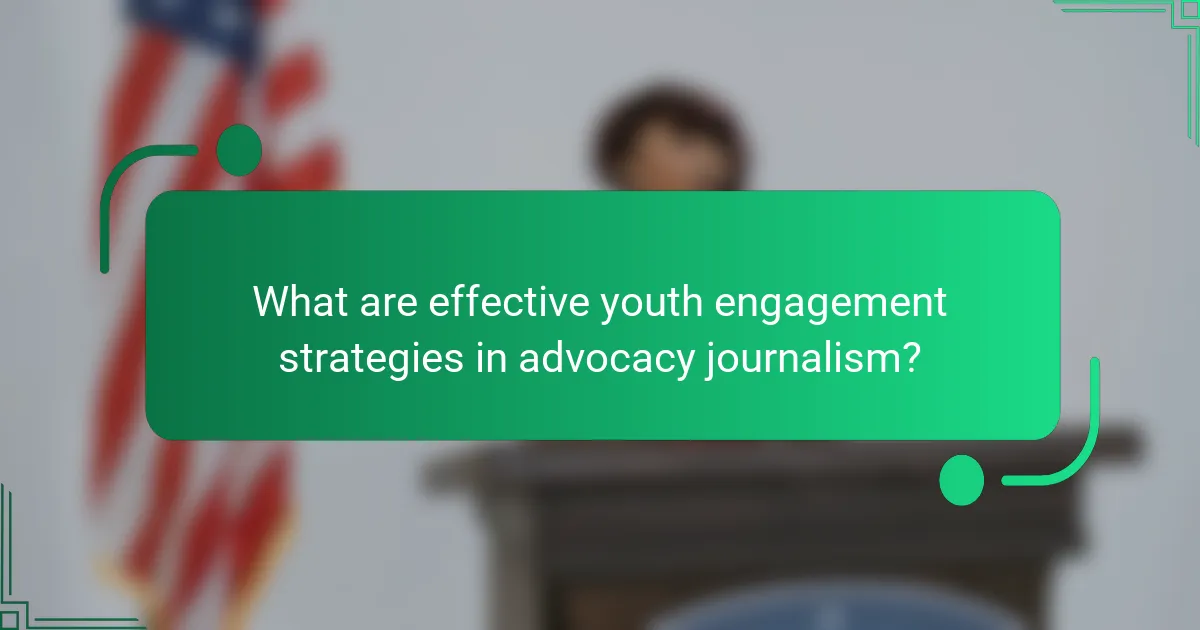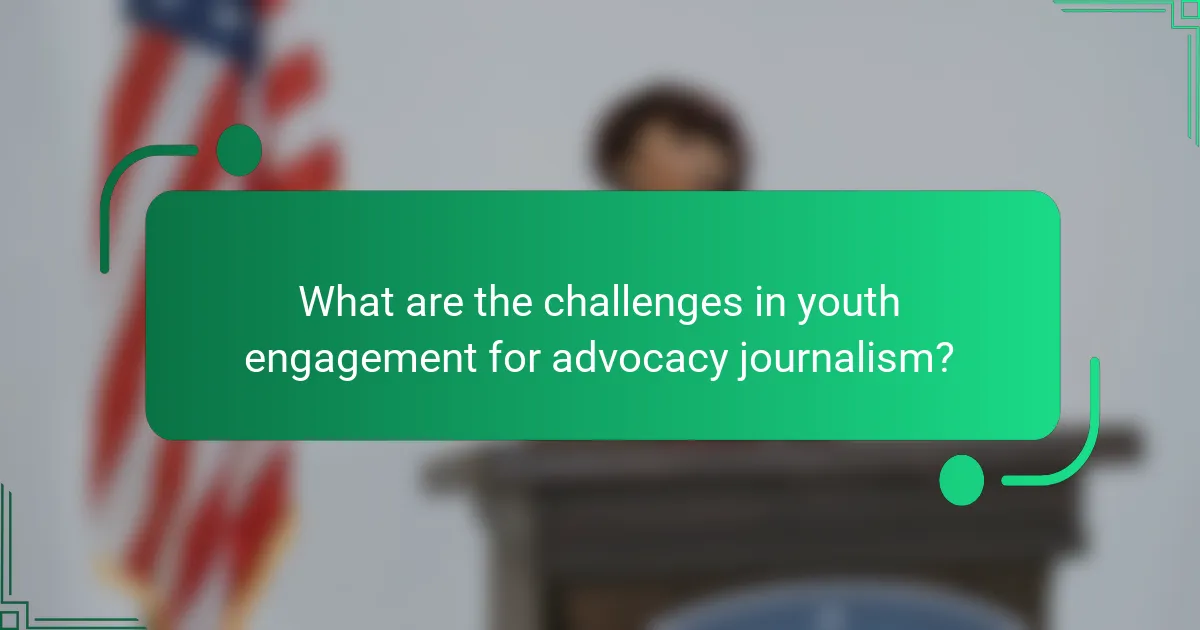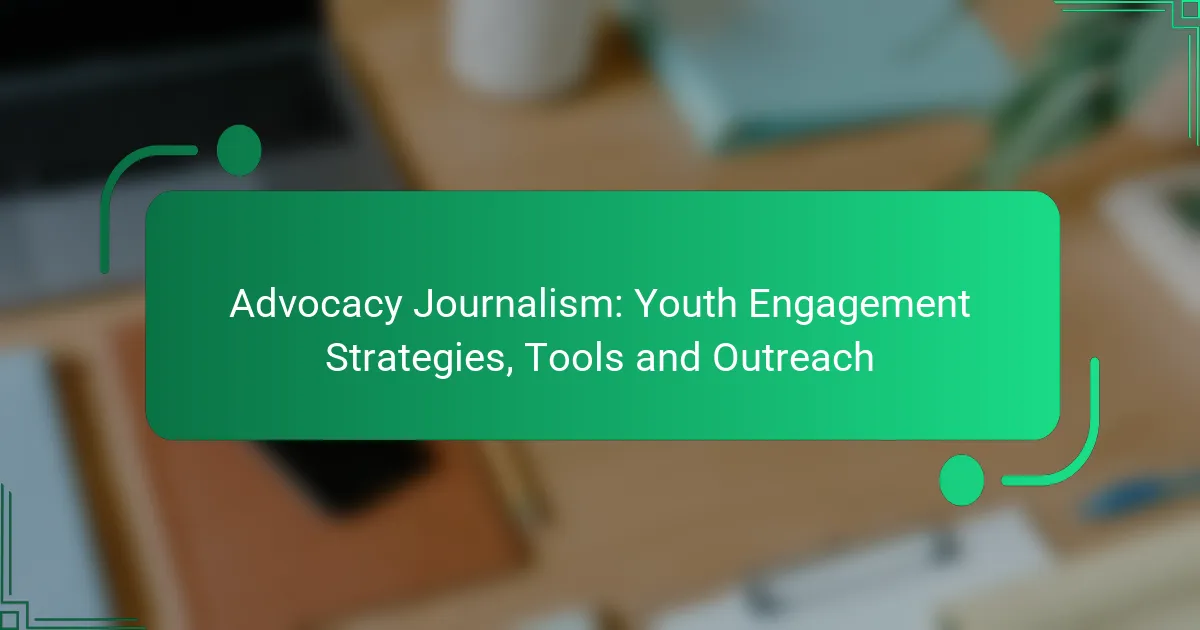Advocacy journalism plays a crucial role in empowering youth by creating inclusive platforms that amplify their voices and encourage active participation. By leveraging technology and community involvement, effective youth engagement strategies foster connections and enhance the impact of young perspectives on pressing issues. Utilizing accessible tools for content creation and interaction further enhances this engagement, ensuring that advocacy journalism resonates with the interests and behaviors of young audiences.

What are effective youth engagement strategies in advocacy journalism?
Effective youth engagement strategies in advocacy journalism involve creating inclusive platforms that empower young voices and encourage active participation. These strategies leverage technology and community involvement to foster connections and amplify youth perspectives on important issues.
Collaborative storytelling initiatives
Collaborative storytelling initiatives allow youth to share their experiences and perspectives through various media formats. By working together, young people can create narratives that reflect their realities, fostering a sense of ownership and engagement in the advocacy process.
Consider organizing workshops where youth can brainstorm, write, and produce stories collectively. This not only builds skills but also strengthens community ties and enhances the impact of the stories shared.
Social media campaigns
Social media campaigns are powerful tools for engaging youth in advocacy journalism. Platforms like Instagram, TikTok, and Twitter provide spaces for young people to express their views and mobilize support for causes they care about.
To maximize impact, campaigns should use visually appealing content and relatable messaging. Engaging hashtags and challenges can encourage participation and help spread awareness quickly among peer networks.
Interactive workshops
Interactive workshops are essential for equipping youth with the skills needed for effective advocacy journalism. These sessions can cover topics such as media literacy, storytelling techniques, and the ethical considerations of journalism.
Incorporating hands-on activities, such as role-playing or group discussions, can enhance learning and retention. Aim for workshops that are accessible and tailored to the interests of the participants to ensure maximum engagement.
Peer-led advocacy programs
Peer-led advocacy programs empower youth to take leadership roles in their communities. By training young advocates to lead discussions and initiatives, these programs foster confidence and encourage active participation in social issues.
Consider establishing mentorship opportunities where experienced advocates guide newcomers. This approach not only builds skills but also creates a supportive network that encourages ongoing engagement.
Community partnerships
Building community partnerships is crucial for effective youth engagement in advocacy journalism. Collaborating with local organizations, schools, and community leaders can provide resources and amplify the reach of advocacy efforts.
Identify potential partners who share similar goals and values. Joint events, campaigns, or projects can enhance visibility and create a stronger collective impact on the issues that matter to youth.

Which tools enhance youth engagement in advocacy journalism?
Several tools can significantly boost youth engagement in advocacy journalism by making content creation and interaction more accessible and appealing. These tools facilitate storytelling, gather feedback, analyze audience behavior, and manage content effectively.
Digital storytelling platforms
Digital storytelling platforms allow young advocates to create and share compelling narratives through multimedia formats. Tools like Adobe Spark, Canva, and Storybird enable users to combine text, images, and videos, making stories more engaging and relatable.
When selecting a platform, consider ease of use and available features. For instance, platforms that offer templates and intuitive design tools can help youth quickly produce high-quality content without extensive training.
Survey and feedback tools
Survey and feedback tools are essential for understanding the perspectives and interests of young audiences. Platforms like Google Forms and SurveyMonkey allow advocates to gather insights on what topics resonate most with youth, enabling tailored content creation.
To maximize effectiveness, keep surveys concise and focused. Aim for a mix of multiple-choice and open-ended questions to capture both quantitative and qualitative data. Regularly analyzing feedback can help refine engagement strategies over time.
Social media analytics
Social media analytics tools help track engagement metrics, providing insights into how youth interact with advocacy content. Tools like Hootsuite and Buffer offer analytics features that reveal audience demographics, post performance, and engagement rates.
Utilizing these insights allows advocates to adjust their strategies based on what content performs best. Regularly reviewing analytics can inform decisions on posting times, content types, and platform selection to enhance outreach efforts.
Content management systems
Content management systems (CMS) streamline the process of creating, publishing, and managing advocacy journalism content. Platforms like WordPress and Wix provide user-friendly interfaces that enable youth to maintain a consistent online presence.
When choosing a CMS, consider factors such as customization options, scalability, and support for multimedia content. A well-organized CMS can facilitate collaboration among young advocates, making it easier to share responsibilities and maintain engagement across various channels.

How can advocacy journalism reach youth effectively?
Advocacy journalism can effectively reach youth by utilizing platforms and strategies that resonate with their interests and behaviors. Engaging content delivered through the right channels fosters connection and encourages active participation.
Targeted social media advertising
Targeted social media advertising allows advocacy journalism to reach specific youth demographics by using data-driven insights. Platforms like Instagram and TikTok enable organizations to tailor their messages based on age, interests, and location, ensuring that content is relevant and engaging.
To maximize impact, consider using eye-catching visuals and concise messaging. Ads should encourage interaction, such as sharing or commenting, to foster a sense of community and involvement.
Engaging multimedia content
Engaging multimedia content, including videos, podcasts, and interactive graphics, captures the attention of young audiences more effectively than traditional text-based articles. This type of content can simplify complex issues and make them more relatable.
For instance, short video clips that highlight personal stories or impactful statistics can be shared across social media platforms. Incorporating elements like quizzes or polls can also enhance engagement and encourage youth to express their opinions.
Influencer collaborations
Collaborating with influencers who resonate with youth can amplify the reach of advocacy journalism. Influencers often have established trust and credibility, making their endorsements powerful tools for spreading awareness about social issues.
When selecting influencers, prioritize those whose values align with the advocacy message. Authentic partnerships can lead to more genuine engagement, as youth are more likely to respond positively to content that feels relatable and sincere.

What are the prerequisites for successful youth outreach?
Successful youth outreach requires understanding their unique needs and interests, as well as establishing trust and credibility. Engaging young people effectively involves using appropriate strategies and tools that resonate with them.
Understanding youth interests
To engage youth, it is crucial to understand their interests, values, and concerns. This can be achieved through surveys, focus groups, or social media interactions, which provide insights into what matters most to them.
Consider tailoring your outreach efforts to reflect current trends, such as environmental issues, social justice, or digital innovation. For example, organizing events around popular topics can attract more participants and foster deeper connections.
Building trust and credibility
Establishing trust and credibility is essential for successful youth outreach. Young people are more likely to engage with organizations or individuals they perceive as authentic and relatable.
To build this trust, be transparent about your goals and intentions. Share stories and experiences that resonate with youth, and involve them in decision-making processes. Avoid using jargon or overly formal language, as this can create barriers to communication.

What are the challenges in youth engagement for advocacy journalism?
Youth engagement in advocacy journalism faces several challenges, including apathy, lack of access to resources, and the digital divide. These obstacles can hinder effective participation and limit the impact of youth voices in important social issues.
Understanding youth interests and motivations
To engage youth effectively, it is crucial to understand their interests and motivations. Many young people are passionate about social justice, climate change, and equality, but they may feel disconnected from traditional media. Tailoring content that resonates with their values can foster deeper engagement.
Utilizing platforms popular among youth, such as social media, can help bridge this gap. Engaging them through interactive content, like polls or challenges, can also spark interest and encourage participation.
Access to resources and training
Limited access to resources and training can be a significant barrier for youth in advocacy journalism. Many young individuals may not have the necessary tools or knowledge to effectively express their views or create impactful content. Providing workshops, online courses, or mentorship programs can empower them to develop their skills.
Organizations can partner with schools or community centers to offer accessible training sessions. Additionally, creating online resource hubs can help youth find the information they need to engage confidently in advocacy journalism.
Overcoming digital divides
The digital divide remains a critical challenge in youth engagement. Not all young people have equal access to technology or the internet, which can limit their ability to participate in advocacy journalism. Addressing this issue requires targeted efforts to provide access to devices and reliable internet connections.
Community initiatives, such as providing free Wi-Fi in public spaces or distributing devices to underprivileged youth, can help bridge this gap. Furthermore, promoting offline engagement strategies, like community meetings or local events, can ensure that all youth have opportunities to participate.
